9 Types of Community Composting Programs For Home Composting
Want to compost at home but are nervous about managing it yourself? Community composting is the perfect start to composting for beginners. There are many types of community composting programs available in different communities. Read on for more about what community composting is, what programs exist, and where to find community composting near you.
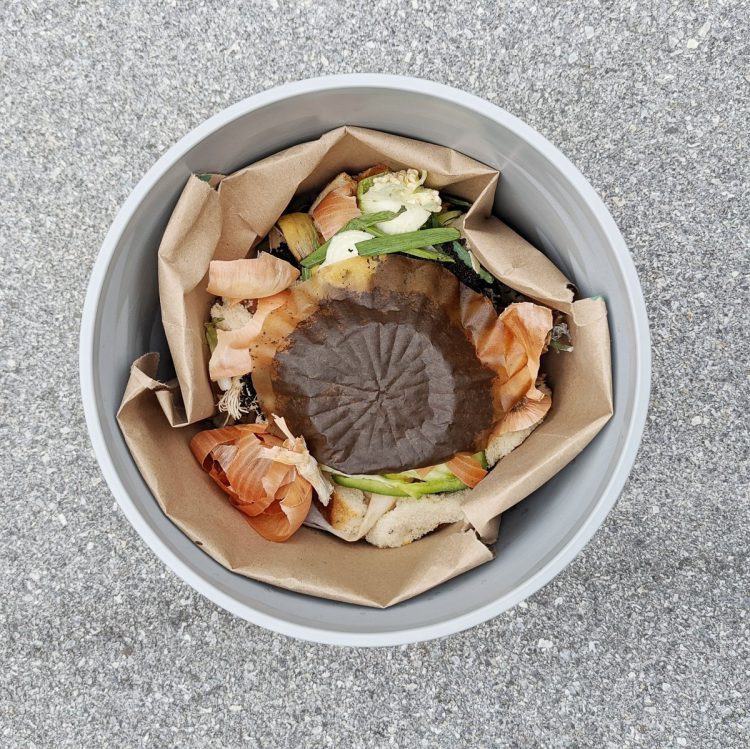
One mention of composting at home and visions of stinky, slimy piles of rotting food scraps pop into most people’s heads. Managing your own compost bin that requires turning and lifting and sifting is certainly an option to reduce food waste and recycle organics. For most people, however, it’s not my favorite option to recommend.
As a self-proclaimed composting nerd, I’ve turned my fair share of those earthy-smelling piles of soil amendment. But I don’t think this is the best option for most people. For the majority of folks who want to compost, from the newly compost-curious to the dedicated zero wasters, community composting is my jam.
What is Compost?
Before getting too far into the details, let’s cover the most common confusion around composting, “compost” as a noun and a verb. The word is often used in both contexts.
Compost (the noun) is the finished soil amendment. It is not soil. Instead, it’s a nutrient-rich, crumbly, dark brown soil-like substance filled with organic matter that benefits the soil. Compost (the noun) is the byproduct of compost (the verb).
Compost (the verb) is the process of breaking down organic matter (greens and browns – anything that ever lived) in a moist environment, often rich with oxygen, whereby worms, bacteria, and other microorganisms consume the organic matter. The organisms break down the organic matter through processes like digestion and leave behind simpler nutrients that plants can access through their roots to fuel healthy growth and development.
Food scraps, leaves, cardboard, and other types of organic matter are composted to become finished compost. And composting is a really affordable way to protect our planet and build more resilient communities, socially and environmentally.
The following comes from the Institute for Local Self-Reliance (www.ilsr.org), a national nonprofit organization working to strengthen local economies, and redirect waste into local recycling, composting, and reuse industries. It is reprinted here with permission.
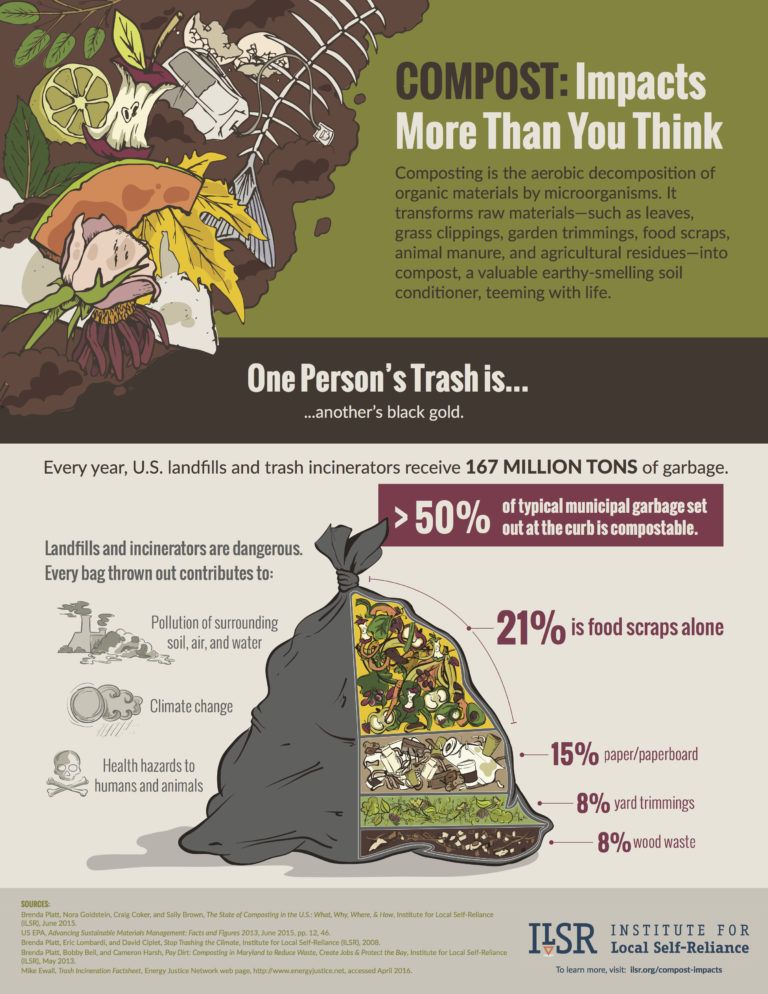
What is Community Composting?
Community composting is the process of recycling organic waste from kitchens, home gardens, and small local businesses through distributed networks of small composting systems and sites within a local community. These locations can include a variety of methods, scenarios, and systems from backyard to schoolyard compost systems and home compost bins to regional collection sites.
The Institute For Local Self-Reliance (ILSR) is one of the most active advocates and helpful resources for promoting and facilitating community composting. They offer many webinars, podcasts, and online resources to help community composters thrive. WasteWell, the curbside composting collection company I own, is a member of ILSR’s Community Composters Coalition, a super helpful group through which community composters can collaborate and share information.
Because community composting can look so different based on the communities in which it takes place, ILSR developed community composting principles to help define what community composting is and how we can help it grow and thrive.
ILSR Guiding Principles of Community Composting:
- Resources recovered: Waste is reduced; food scraps and other organic materials are diverted from disposal and composted.
- Locally based and closed loop: Organic materials are a community asset, and are generated and recycled into compost within the same neighborhood or community.
- Organic materials returned to soils: Compost is used to enhance local soils, support local food production, and conserve natural ecology by improving soil structure and maintaining nutrients, carbon, and soil microorganisms.
- Community-scaled and diverse: Composting infrastructure is diverse, distributed, and sustainable; systems are scaled to meet the needs of a self-defined community.
- Community-engaged, empowered, and educated: Compost programming engages and educates the community in food systems thinking, resource stewardship, or community sustainability while providing solutions that empower individuals, businesses, and institutions to capture organic waste and retain it as a community resource.
- Community supported: Aligns with community goals (such as healthy soils and healthy people) and is supported by the community it serves. The reverse is true, too; a community composting program supports community social, economic, and environmental well-being.
For today’s purposes, we’re discussing community composting simply as a means to compost in your local area with the help of a neighbor or two or assistance from an organization with composting at its core. Basically, we’ll consider all the ways you can compost that involve your niehgbors helping you turn your food scraps into finished compost in your own community.
Benefits of Community Composting
Composting is great for the environment. It helps build healthy soil, cleans watersheds and water supplies, increases carbon sequestration, and reduces waste in our landfills and incinerators. As shown in the diagram below from the ILSR, it’s an important component of the Hierarchy to Reduce Food Waste.
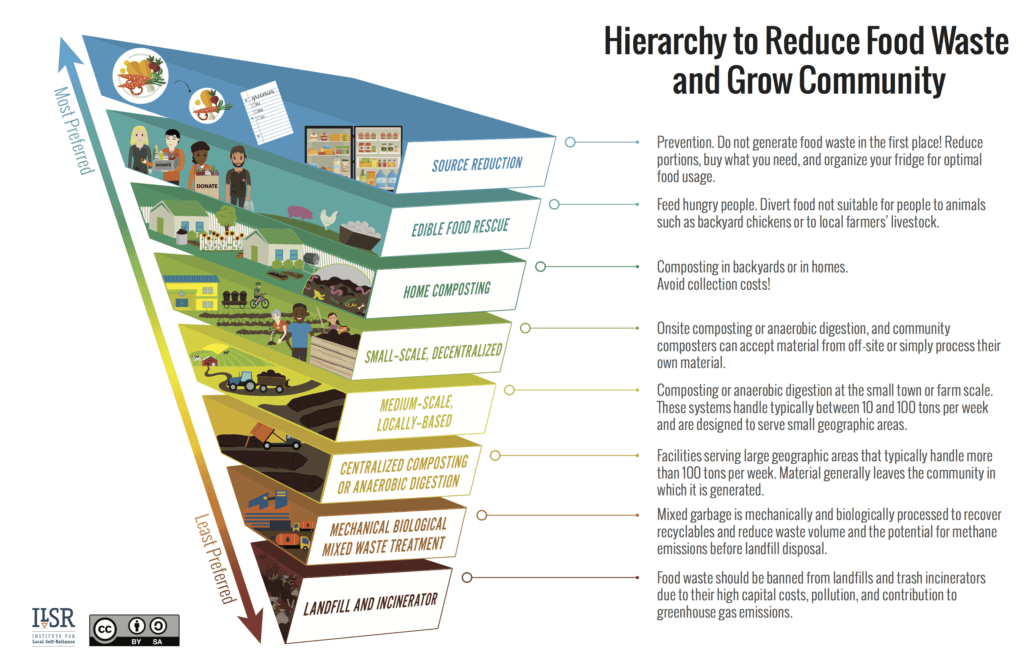
While any composting is generally better than tossing our organic waste in the trash, community composting also has some unique benefits over larger-scale composting systems.
Community Composting Results in Healthier Local Soils
When we keep food scraps and other organic matter in the local community and turn that matter into finished compost, we can use it to create healthier soil. Healthier soil is great for community and home gardens, thriving vegetation, healthier watersheds and ecosystems overall, and increased sequestration of carbon into the soil to reduce excess carbon in our atmosphere.
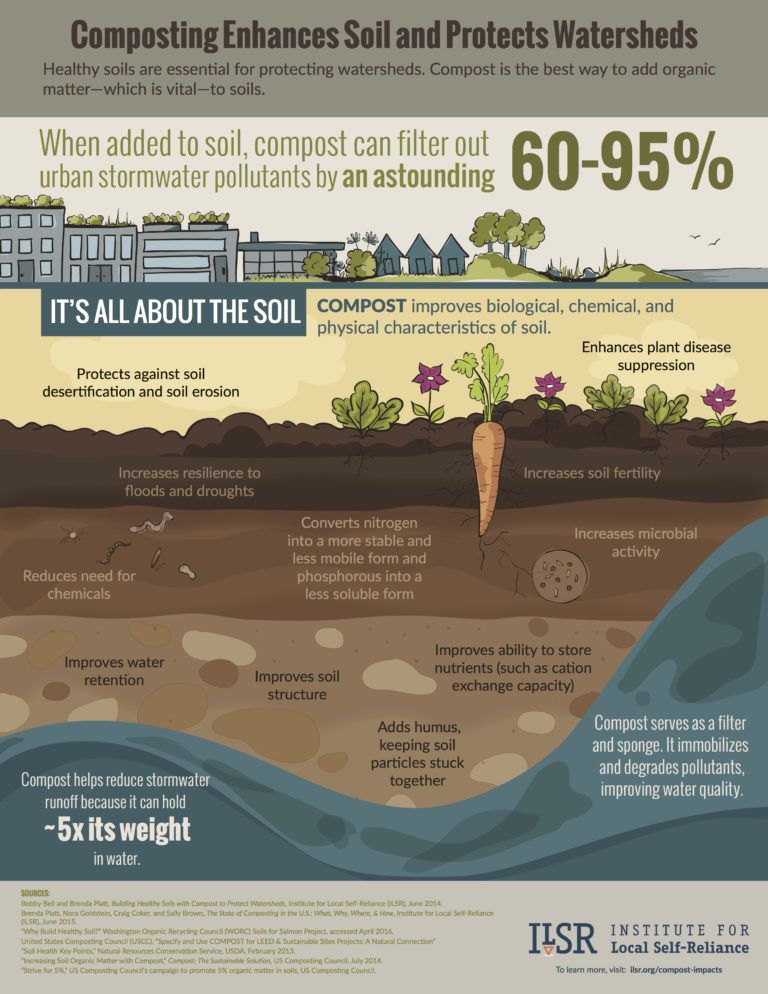
Community Composting Causes Less Truck Traffic Hauling Waste
Retaining local food waste and other yard waste in our communities results in less truck traffic required to otherwise transport that material to faraway landfills, incinerators, and other depositories. This results in less air pollution, less noise pollution, and fewer carbon emissions.
Community Composting Enhances Food Security and Fewer Food Deserts
Community composting operations often support home gardens, local community gardens, community farms, and other food sources. These local food supply sources promote food security and accessibility, especially in food deserts that lack an abundance of grocery stores.
Community Composting Creates More Local Jobs
Community composting jobs typically create more jobs than large-scale waste management alternatives. Consider this graphic from the Institute for Local Self-Reliance.
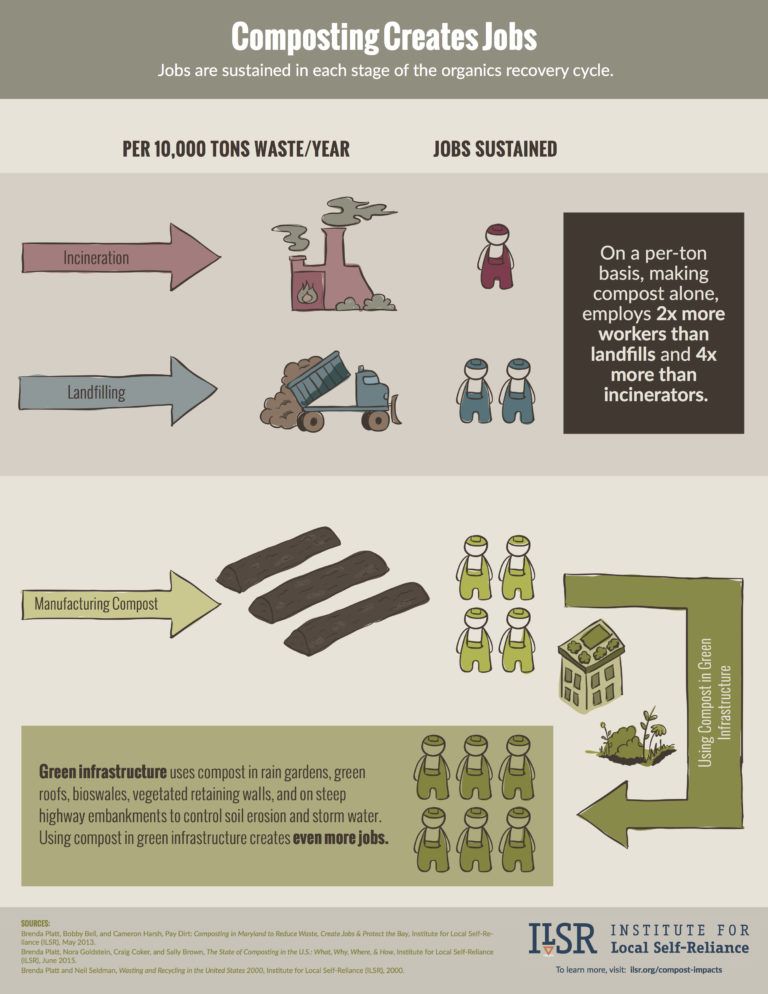
Community Composting Helps Composting Education Flourish
Transporting waste to faraway places too often results in an “out of sight, out of mind” complacency. Local composting initiatives, however, help enhance education around the benefits of composting. More people are involved and understand the benefits. This not only supports further growth of community composting programs but also increases the likelihood that programs become more formalized and streamlined to increase and facilitate participation.
Furthermore, according to the ILSR, “When materials are collected and transported out of the community for processing, few if any of these benefits are realized at the local level. In addition, community-scale operations can move from concept to operation in a relatively short time frame. And community composting can build critical support for and participation in future citywide food scrap recovery programs.”
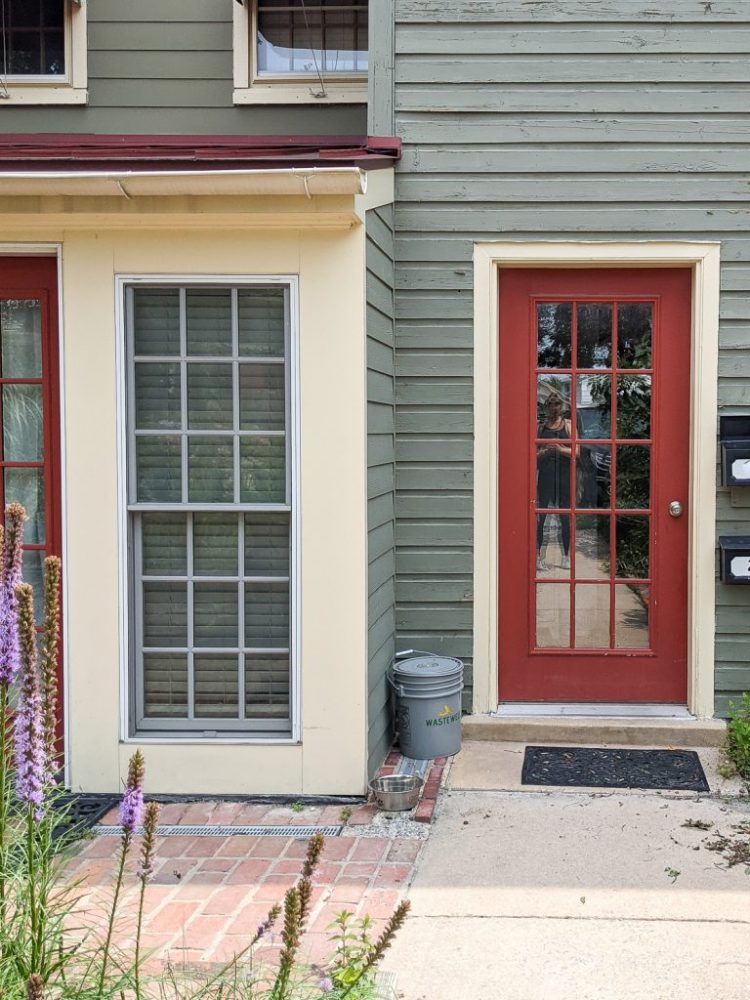
9 Types of Community Composting Programs For Home Composters
If you’re thinking about starting to compost at home, community composting is by far the easiest option in our opinion, if it is available to you. Some people may love the satisfaction of managing the process themselves, and that’s amazing. But I want to focus on the easiest community composting options for those just looking to reduce their organic waste and not necessarily keen on taking on more responsibility.
Let’s dive into some common community composting systems and processes so you can figure out which one works best for you.
1. Use a Collection Service (Private or Municipal Hauler)
I might be biased because I run a compost collection service in our local community, but I really do think this is the easiest way to compost if it is accessible to you. Forward-thinking municipalities offer organics collection services in conjunction with their trash and recycling pickup. Many places, especially those around urban centers, also have private companies that offer organic recycling services.
If you have access to a municipal or commercial compost collection service, it is one of the simplest and most effective composting methods. They generally tell you exactly what they collect, and they come right to your door to haul away your precious organic waste.
Additionally, most of these services use commercial or industrial composting processes. Thus, they can take a wider array of compostable items, including things like bioplastics, that you may not be able to compost effectively at home or in smaller shared composting systems.
Much like our waste and recycling systems today, large-scale aggregation of organic waste will likely play a significant role in effectively managing our collective organic waste.
I understand, however, that not all locations have compost collection services nor is it financially accessible to everybody. If that is the case for you, consider one of these other community composting options.
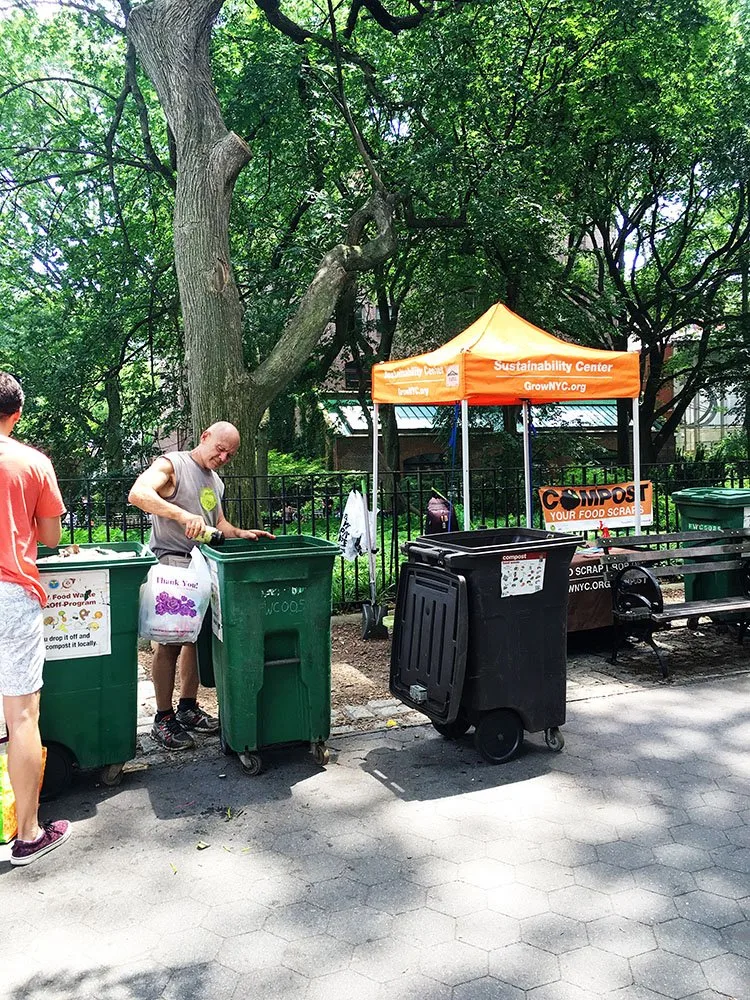
2. Farmers’ Market Organic Recycling Drop-Off Site
Many farmers’ markets have food scrap drop-off sites. Some farmers’ markets work with municipalities while others collaborate with private composting companies to offer customers an option to drop off their food scraps for organic recycling.
Sometimes these programs cost money to use, especially if they are managed by a private compost service. The fees cover costs of employee time to manage the market as well as fees to process the food scraps.
If you live near a farmers’ market that accepts food scraps for composting, you can easily store food scraps in your freezer or in a reusable container in your fridge for several days or even a couple of weeks between drop-offs. Alternatively, if you have an airtight bucket, you can keep your food scraps in these buckets for several weeks without issues.
Check out this person who drops food scraps at their local farmers’ market.
3. Municipal Organic Recycling Drop-off Sites
Many municipalities host drop-off sites for yard waste. Increasingly, municipalities see the value in diverting food scraps and other organic waste from landfills as well, and they offer drop-off locations for residential food scraps.
If you’re not sure if this is available in your municipality, check out the municipality website and dive into their waste management webpages. A quick search for ‘composting’ or ‘organic recycling’ or ‘organic waste’ on their site will likely lead you to more information about composting options available in your city or town.
4. Co-op Composting Program or Partnership
Some grocery stores, especially those set up at co-ops, and other types of food markets with a focus on sustainability and local economies partner with composting companies to offer food scrap drop-off services.
While they each have unique operations, a typical structure might involve paying a small fee ($5 or so) at the checkout counter for a collection bucket you take home with you. You can return the bucket to a central drop-off location and purchase a new bucket on your way out of the store. The compost collection service stops by the store a few times a week to swap clean buckets for full buckets and the cycle continues.
The food market often gets a small financial benefit from each bucket purchased in exchange for the space and time they spend overseeing the program.
5. Community Garden Compost Pile
If you know of shared community gardens in your area, reach out to see if they accept food scraps from local residents. Finished compost is garden gold, so if they have the manpower to manage a compost pile, they’re probably willing to accept your food scraps to build up their natural soil amendments.
6. School Garden Compost Pile
Many schools run small vegetable gardens. Depending on the system, school lunch food scraps may provide enough feedstock for compost for a school garden. However, it can’t hurt to ask if they can utilize your organic waste.
If you’re dropping off food scraps, you may even consider volunteering a bit of your time to help them manage the compost pile in exchange for the space and effort they share to reduce organic waste in the community.
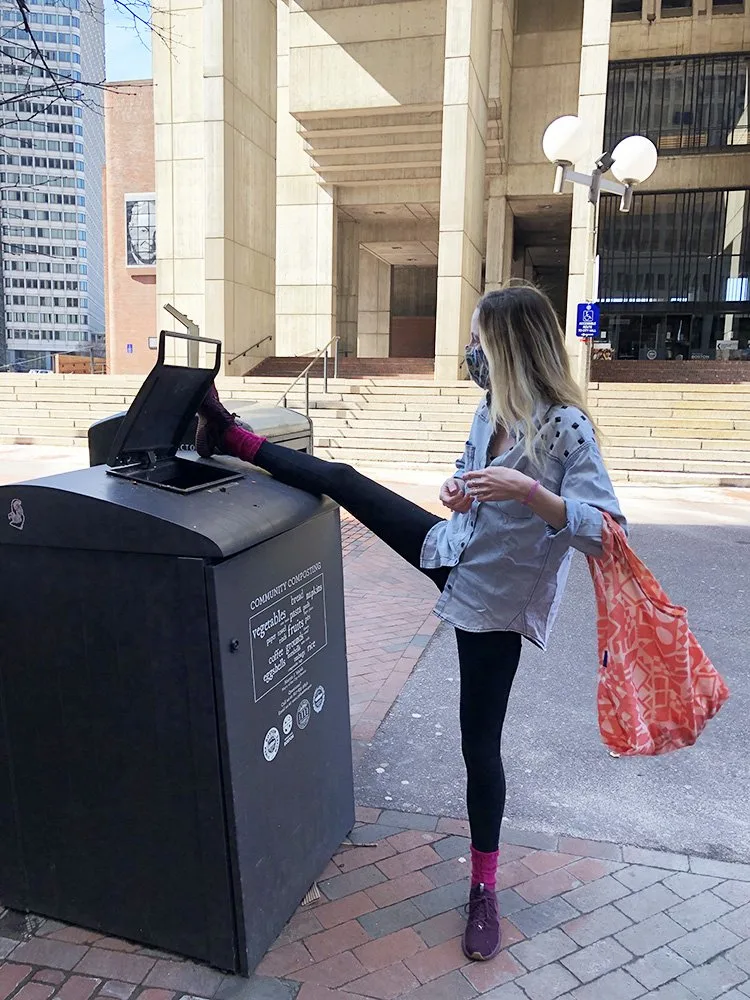
7. Public Collection Bins For Food Scraps
I’ve seen a growing number of public collection bins for food scraps in many places. Where composting is required by regulation, many restaurants, stores, and public spaces like airports have compost bins next to their trash and recycling receptacles. While they can’t manage significant drop-offs of all of your food scraps, use these bins when you’re out and about to ensure your organic waste doesn’t end up in a landfill.
Some municipalities, like Boston, Massachusetts, have also started programs like Project Oscar. This program provides large collection bins in public open spaces where residents can drop off their kitchen scraps on their own time.
Some of these programs remain pilot programs, so they are not open to all residents just yet. However, the more people use them and advocate for them, the more likely municipalities are to allocate funding for them in the future.
Check out this woman who drops her food scraps in a municipal compost bin.
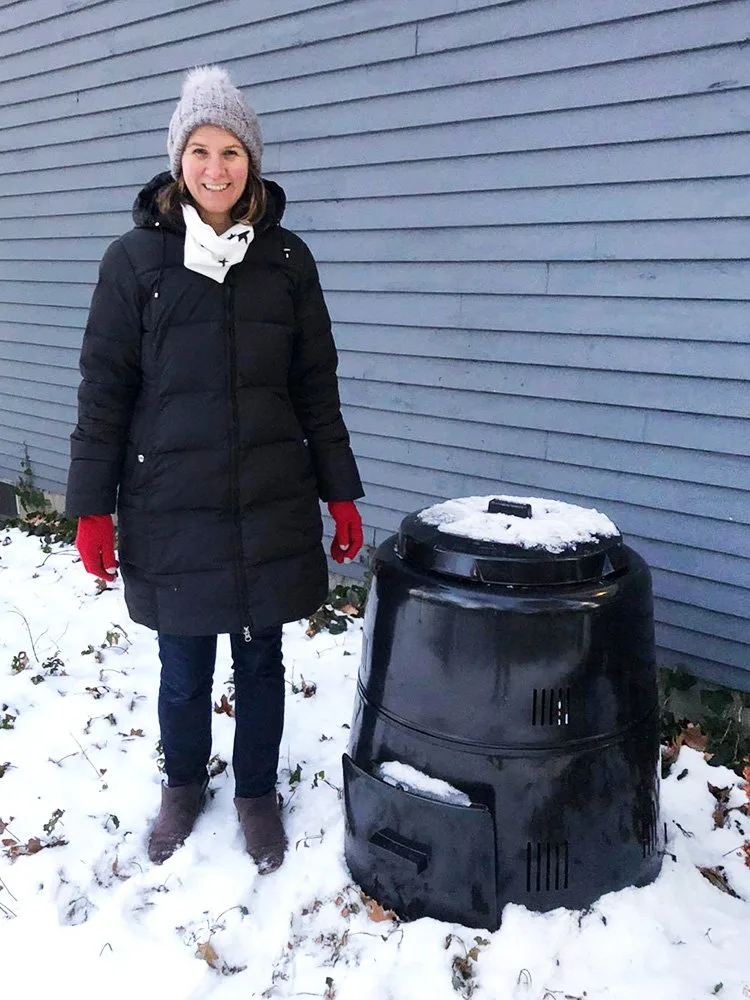
8. Neighbors’ Compost Bin
Never underestimate the power of a good neighbor, especially one who composts. Many composters are happy to share their bin space. If you know your neighbor composts, don’t trash them for trying to save the planet. Their compost bin won’t bring all the critters to your yard or reduce your property value. In fact, as more people compost and significantly reduce their waste, municipal waste management costs may decrease and provide a benefit to taxpayers.
Instead, ask if you can borrow some space in their bin. With their permission, periodically drop your food scraps in their compost bin for a simple, eco-friendly community win that is easy for you and provides feedstock for their finished compost.
Check out this woman who shares her compost bin with neighbors.
9. ShareWaste Compost Host
Don’t know a neighbor who composts? Download the ShareWaste app and find a compost host in your area. Provided you follow their rules about what types of items they accept, they’ll likely be happy to let you drop off your food scraps in their bin. You drop your compost scraps, and they do all the heavy lifting to process it.
Collective efforts to compost are certainly the future of our organic waste management system. It’s just not reasonable or feasible to expect everyone to manage their own organic waste individually. Community composting is easier, creates connection, and is often cost-effective when done at a reasonable scale.
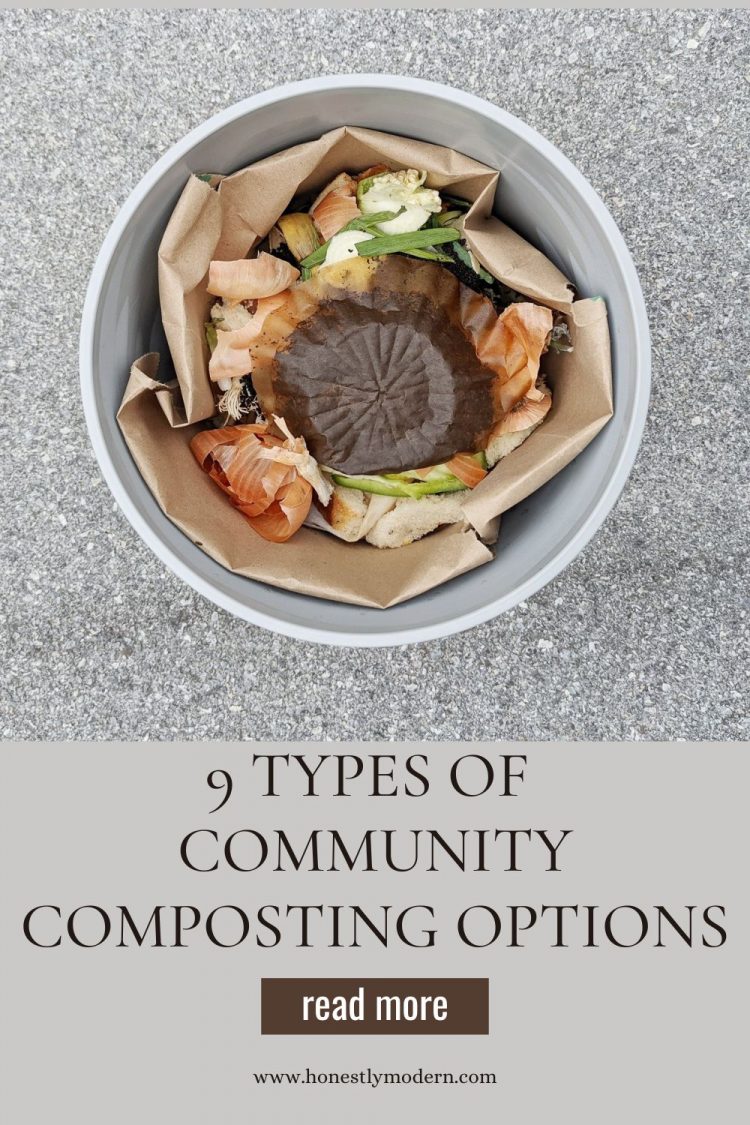

Jen Panaro
Jen Panaro, founder and editor-in-chief of Honestly Modern, is a self-proclaimed composting nerd and advocate for sustainable living for modern families. To find her latest work, subscribe to her newsletter, Stepping Stones.
In her spare time, she’s a serial library book borrower, a messy gardener, and a mom of two boys who spends a lot of time in hockey rinks and on baseball fields.
You can find more of her work at Raising Global Kidizens, an online space to help parents and caregivers raise the next generation of responsible global citizens.







